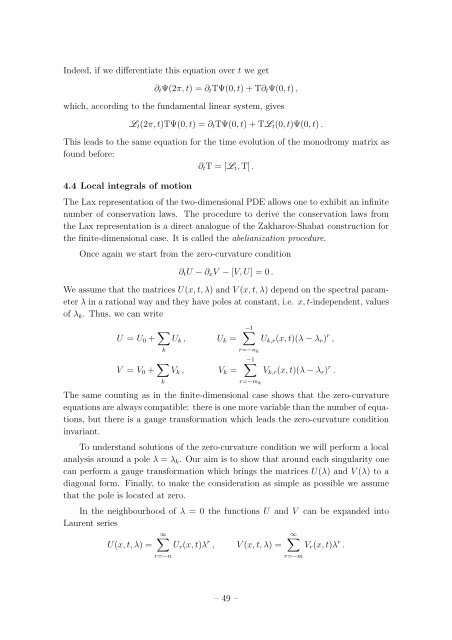Student Seminar: Classical and Quantum Integrable Systems
Student Seminar: Classical and Quantum Integrable Systems
Student Seminar: Classical and Quantum Integrable Systems
You also want an ePaper? Increase the reach of your titles
YUMPU automatically turns print PDFs into web optimized ePapers that Google loves.
Indeed, if we differentiate this equation over t we get<br />
∂ t Ψ(2π, t) = ∂ t TΨ(0, t) + T∂ t Ψ(0, t) ,<br />
which, according to the fundamental linear system, gives<br />
L t (2π, t)TΨ(0, t) = ∂ t TΨ(0, t) + TL t (0, t)Ψ(0, t) .<br />
This leads to the same equation for the time evolution of the monodromy matrix as<br />
found before:<br />
∂ t T = [L t , T] .<br />
4.4 Local integrals of motion<br />
The Lax representation of the two-dimensional PDE allows one to exhibit an infinite<br />
number of conservation laws. The procedure to derive the conservation laws from<br />
the Lax representation is a direct analogue of the Zakharov-Shabat construction for<br />
the finite-dimensional case. It is called the abelianization procedure.<br />
Once again we start from the zero-curvature condition<br />
∂ t U − ∂ x V − [V, U] = 0 .<br />
We assume that the matrices U(x, t, λ) <strong>and</strong> V (x, t, λ) depend on the spectral parameter<br />
λ in a rational way <strong>and</strong> they have poles at constant, i.e. x, t-independent, values<br />
of λ k . Thus, we can write<br />
U = U 0 + ∑ k<br />
V = V 0 + ∑ k<br />
U k , U k =<br />
V k , V k =<br />
∑−1<br />
r=−n k<br />
U k,r (x, t)(λ − λ r ) r ,<br />
∑−1<br />
r=−m k<br />
V k,r (x, t)(λ − λ r ) r .<br />
The same counting as in the finite-dimensional case shows that the zero-curvature<br />
equations are always compatible: there is one more variable than the number of equations,<br />
but there is a gauge transformation which leads the zero-curvature condition<br />
invariant.<br />
To underst<strong>and</strong> solutions of the zero-curvature condition we will perform a local<br />
analysis around a pole λ = λ k . Our aim is to show that around each singularity one<br />
can perform a gauge transformation which brings the matrices U(λ) <strong>and</strong> V (λ) to a<br />
diagonal form. Finally, to make the consideration as simple as possible we assume<br />
that the pole is located at zero.<br />
In the neighbourhood of λ = 0 the functions U <strong>and</strong> V can be exp<strong>and</strong>ed into<br />
Laurent series<br />
∞∑<br />
∞∑<br />
U(x, t, λ) = U r (x, t)λ r , V (x, t, λ) = V r (x, t)λ r .<br />
r=−n<br />
r=−m<br />
– 49 –

















